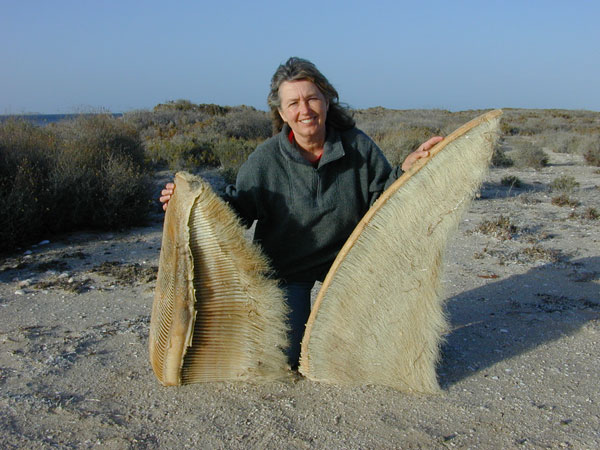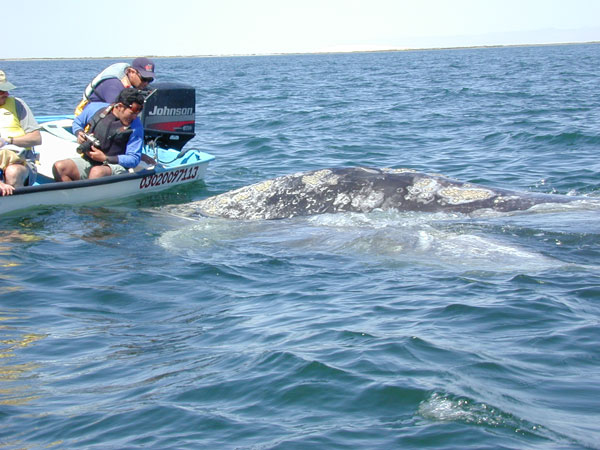Migration of the Gray Whale
The gray whale migrates between its summer feeding grounds in the North Pacific and Bering Sea and its winter breeding grounds in the lagoons of Baja California. (NASA image edited by GA) |
Whale watching boats are common along the coast of California during this seasonal migration. (GA image) |
Perhaps the most common cetacean (whale) seen in California is Eschrichtius robustus, usually called the California gray whale (or simply, the gray whale). The genus Eschrichtius is from the Danish whale biologist Eschricht. The species robustus refers to the gray whale's robust size. This species is limited to the North Pacific and is unique in that almost the entire population follows a seasonal migration along the coastline of western North America. Most other whale species have separate populations in different oceans and/or hemispheres; each population has a separate migration with different months of the year and different routes. However, almost all of the gray whales spend the summer months (June, July, and August) in the Bering Sea area between Alaska and Russia. A few even venture north into the Arctic Ocean. In the fall the majority of the population migrates south, along the west coast of Canada and the United States, ending up in the quiet lagoons of Baja California during the winter months (January, February, and March). In the spring the population returns to the Bering Sea area. This 12,000 mile roundtrip may be the longest migration of any mammal on Earth. (Recently there are a few gray whales that have been found to miss the full migration.)
Small 'resident' populations of gray whales are showing up in the northwestern United States. These whales generally make the southward migration but drop off on the northward migration to spend the summer in shallow coastal areas. Two such groups are being studied - one near Depoe Bay, Oregon (about 33 whales in 2005) and one in Puget Sound, Washington (about 55 whales in 2005). In 2006 a report of gray whales, seen during July/August, off San Miguel Island (near Santa Barbara) is very interesting and something to watch in case another such 'resident' group is forming in this area. Gray whales should have completed their migration north of San Miguel Island by July. The report was sent to the coordinator for the Santa Barbara 'Gray Whales Count' project that organizes volunteers to count northbound gray whales off Santa Barbara during the winter and spring.
There is a small, entirely separate, population of North Pacific gray whales in Korean waters. They are very rare and may be on the way to extinction. These two groups do not appear to interact at all and little is known of the status of the rare Korean stock.
|
This sequence shows a young gray whale feeding on mysid shrimp in the California kelp beds. Although bottom feeders by nature, the gray whale will surface-feed occasionally. At the surface the white baleen plates can be seen along the left side of the whale's mouth as the whale takes a mouthful of seawater (with mysids) and some kelp. Water can be seen spraying out the left side of this whale's mouth, in the last picture, as it uses its tongue to push the mouthful of water through the baleen. (SA images) |
| Filter feeding on bottom zooplankton during the summer months is the primary activity of the gray whale in the Bering Sea. There are enormous plankton blooms in polar marine areas during summer months because there is continual light (24 hours a day) for a month or two. This constant illumination causes a large phytoplankton (plant plankton) bloom that is followed by a large zooplankton (animal plankton) bloom. The gray whale capitalizes on this incredible bloom in the Arctic and specializes in feeding on bottom dwelling zooplanktonic crustaceans (mostly amphipods). They suction feed near the bottom of the ocean in relatively shallow water (rarely more than 250 feet deep), leaving large pits in the muddy bottoms. Although some instances of feeding have been reported during the migration route and in Baja California, it is believed that the bulk of their nutrition is taken in their polar feeding grounds. |
 |
The light colored baleen of the gray whale is a rack of parallel baleen plates lining the upper jaw. The frayed inside (on the right in this picture) keeps zooplankton inside the mouth of the gray whale during filter feeding. The outside of the plates is smooth (on the left in this picture) and was the portion of the baleen used by whalers to make corset stays, yarn winders, and umbrella ribs. (SA image) |
| Filter feeding whales use baleen to strain their prey from the water. The group of whales that filter feed (like the gray whale), using baleen, is called the mysticeti and they rely almost entirely on small fish and zooplankton as their food source. Other whales, like the killer whale, sperm whale, dolphins, and porpoises have teeth for catching larger animal prey. These toothed whales are called the odontoceti and lack baleen. The baleen of the Gray Whale is light in color, coarse and short. It lines the entire upper jaw. Their lower jaw is just gums. During feeding a large amount of water (with zooplankton) is taken into the mouth, the mouth closed a little so that the baleen is just touching the bottom gums, then the tongue is used to squeeze the water out through the baleen. The baleen plates (stacked closely together and frayed on the inside) act like a sieve, letting the water through but retaining the zooplankton. The zooplankton is then licked off the baleen by the tongue and swallowed. |
 |
The pleats in the throat of this gray whale are easily seen as it breaches, facing away from the camera, with the underside of its body toward us. (SA image) |
| The throats of gray whales have a few pleats that allow the throat to expand a little during feeding. Many of the filter feeding whales have numerous pleats allowing their throats to expand many times their normal size during feeding, like a big balloon filled with water. The gray whale does most of its feeding on the bottom, suction feeding the dense aggregations of Arctic crustaceans, and does not need the large quantities of water needed by midwater filter feeding whales. Its pleats are rather small when compared to most of the other mysticetes. Occasionally a gray whale can be seen filter feeding at the surface, with its head out of the water. If this happens you can see the water streaming out through the baleen. Most baleen whales have one side of their baleen worn more than the other. This is believed to be similar to our human tendency to be right handed or left handed. The majority baleen whales have their right side worn more than their left side … an interesting correlation. |
 |
The relative size of the gray whale mother can be seen next to this skiff. Her baby has just submerged next to her. (GA image) |
| At full size the gray whale is about 35 to 50 feet in length and weighs 20-40 tons. It needs 65 tons of food annually to be healthy and migrate. The small zooplanktonic crustaceans that make up the majority of the gray whale's diet are called amphipods but the gray whale has been known to consume other crustaceans like shrimp, mysids, and krill. The months of summer feeding in the Arctic allow the gray whale to add to its thick blubber layers. The thick layer of blubber under the skin of a whale is not only an insulation from the cold water but also a storage area for food needed during the long migrations. If a whale does not get enough to eat it begins to use up its blubber reserves and starving whales can be recognized by their back showing their vertebrae as well defined bumps. A healthy gray whale will naturally have only a slightly bumpy back (with their much reduced dorsal fin showing as a small bump). Sometimes a nursing mother gray whale will have a bumpy back (but this is understandable since she is expending a lot of calories producing milk for her nursing baby). |
|

